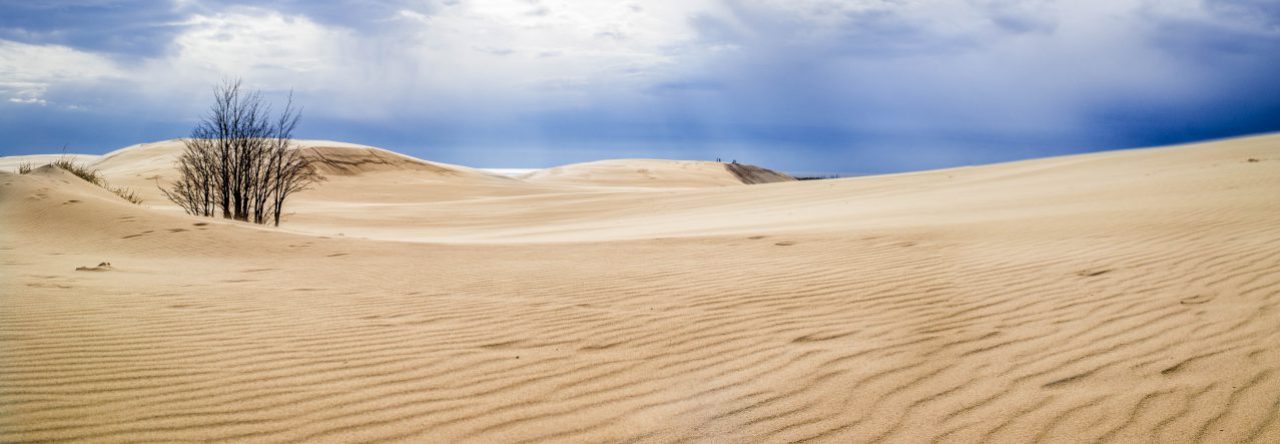
Steam coming off Mammoth Hot Springs
This post contains a lot of information about driving around Yellowstone. Here is a link to a map of the park, that will probably be a helpful reference while you read about our first day in Yellowstone.
Our first day in Yellowstone, we came into the park from Cody. I really believe this played a hand in our ability to see so much of the park in just one day. Unlike the west entrance, there was no line coming in from the east side of the park. The first point of interest coming in this way is Yellowstone Lake and the Fishing Bridge area. This is one of the lesser-visited parts of the park and it felt like we were the only people around for miles.

Yellowstone Lake (above) is a sight to behold. Situated at 7700 feet above sea level and taking up 132 square miles, Yellowstone Lake is the largest high elevation lake in North America. Because of the large surface area, sudden gusts of wind can create large waves making open water crossings of the lake very challenging. Because of that and the cold water temperatures, boating on Yellowstone Lake is not incredibly common.
 From Fishing Bridge, we headed north to Canyon Village and one of my must-sees, Grand Canyon of the Yellowstone. There is a very large parking area in the canyon area and we had no trouble finding a spot to park. One of the best views of the falls can be found at the Artist Point trailhead (left). I love how even unedited photos of the waterfall look like a watercolor painting. This is one of the most popular areas to hike in the park with plenty of hiking trails for all abilities. For more information about hiking in Yellowstone, visit NPS.gov.
From Fishing Bridge, we headed north to Canyon Village and one of my must-sees, Grand Canyon of the Yellowstone. There is a very large parking area in the canyon area and we had no trouble finding a spot to park. One of the best views of the falls can be found at the Artist Point trailhead (left). I love how even unedited photos of the waterfall look like a watercolor painting. This is one of the most popular areas to hike in the park with plenty of hiking trails for all abilities. For more information about hiking in Yellowstone, visit NPS.gov.
The color of the rock makes The Grand Canyon of the Yellowstone one of the most unique waterfalls I have ever seen. At one time a geyser basin was located at what is now the base of the waterfall. The heat and chemical activity of those geysers created rhyolite, a soft and brittle rock. The rhyolite reacts to oxygen in the air and in effect, the canyon walls are rusting, which gives it that unique yellow color.
From Canyon, we headed toward Mammoth. The drive through that part of the park felt longer than going from Lake to Canyon, but maybe it was just that there isn’t anything to stop and see from Norris to Mammoth. I’m not sure if this is normally the route you would take to get from one area to another, but the road from Tower/Roosevelt to Canyon was closed for construction in 2021.

Mammoth Hot Springs (top and right) was another feature on my Yellowstone Must-See list. I had seen photos of the unique, stair-like geothermal feature and wanted to see it for myself. The water in the springs container calcium carbonate that over time cools and creates these unique rock formations. It was interesting walking around and seeing how the pools have shifted over time, as evidenced by forests of dead trees with white, calcified bases.
From Mammoth, we headed to Tower/Roosevelt and this is where we encountered our biggest “jam” of our time in the park. This time, instead of elk, it was a mother bear with two cubs (viewed from a safe distance, of course, and with a ranger standing by with bear spray). It was super cool to see these wild animals through a zoom lens. It was definitely better than seeing them at the zoo!
After our bear encounter, we headed out the Northwest Entrance of the park to Gardiner for dinner. Be sure to stop back next week as I share about our day of exploring geysers and hot springs!
Thanks for stopping by! To read more about this trip, check out the Epic National Park Road Trip. To read about some of our previous trips, visit my Trips Page. If you like my photos be sure to “like” my Facebook Page and follow me on Instagram! You can purchase prints on Etsy and Fine Art America. To see inside my camera bag, check out my updated Gear Page.
Pin This:



